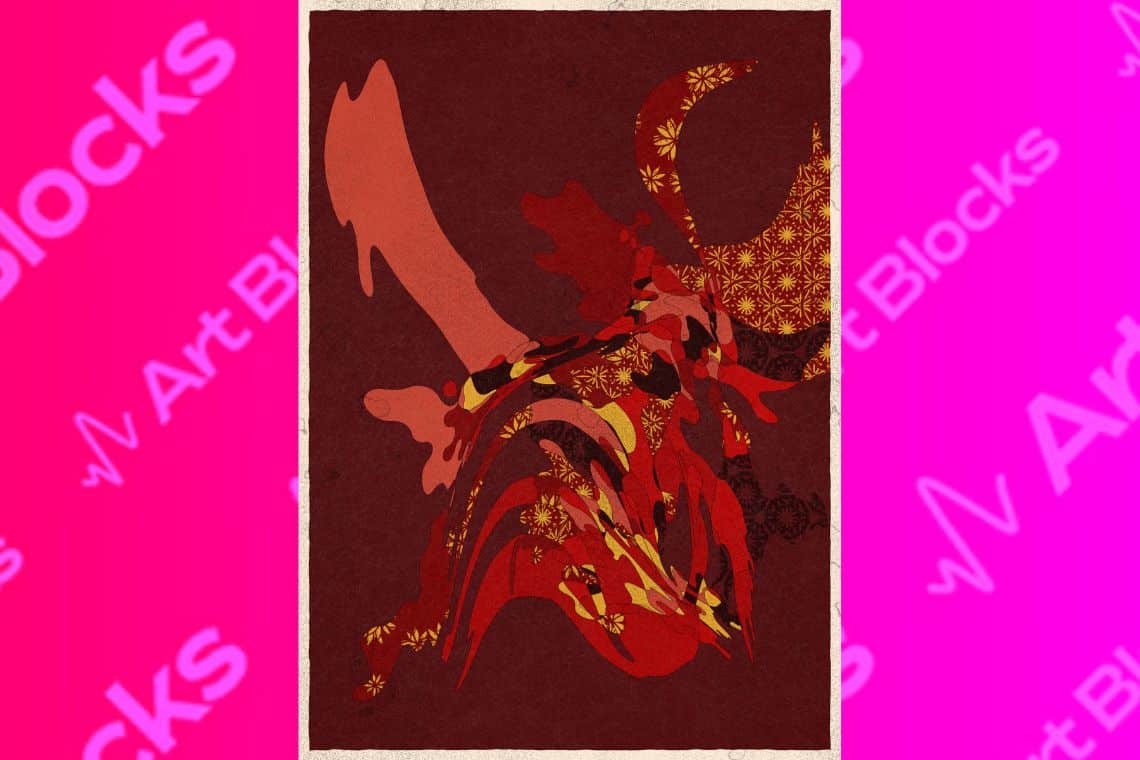Emily Xie is an NFT artist of increasing renown in the generative art world. Her focus is on exploring patterns, texture and materiality.
In Xie’s most notable work to date, Memories of Qilin, she draws inspiration from the colours and patterns of traditional East Asian art and strives to channel the sense of fluid movement found in classical Chinese brushwork in each composition. I spoke with Xie about how she became a generative artist, her influences and how she sees the space evolving.
Summary
Tell me about becoming an artist
Becoming an NFT artist, that was pretty intriguing to me. I had a friend who reached out who was telling me about the NFT space. And he told me about these platforms, for example, artblocks, and from there it was history.
You know, from there, I started making NFT’s and realised wow, for the first time, there’s a technology that allows this art form that is like infinitely reproducible, because it is just pixels on a screen – just something you would make with code that you would put out on the Internet – usually for people to see and interact with. So NFT’s for the first time provided some sort of technology to make it collectible to assign rarity to something that is otherwise infinitely reproducible. And so I made that switch and I’m no longer working as a software engineer. I am now a full time artist.
Cool, so the technology provides rarity to something that is infinitely reproducible?
Yeah, it assigns rarity to something that’s infinitely producible so that it could actually be collected. So for the first time it provides an elegant way of allowing flexibility and now in the generative art space there is such a thing as having a collector base. So now there’s the ability for one to be a full-time artist to make a living off of it which was very hard to do before. For us to afford [to do it].
What are your influences as an artist?
The collection that’s probably the most known is Memories of Qilin. That was the collection that really launched my career. And for that I was heavily inspired and influenced by East Asian woodblock artists like Hokusai. And so a lot of wood blocks, sort of the patterns, the colours, the sense of flatness that was inspirational for Memories of Qilin. But at the same time I also looked to a lot of, you know, Chinese brushwork, Chinese painting and that sort of like fluidity, that sort of sense of movement.
That sense of large whooshing brushstrokes. That was also very inspiring for me as well. So I definitely let coming from an art history background inspire me to the great masters in my current practice. And so that was definitely the inspiration for Memories of Qilin.
But more lately I’ve been inspired by early 20th century artwork and artists. You probably saw that in the series Off Script. You probably saw the influence of Matisse. His cutouts were greatly influential for me. I was inspired, certainly by Picasso as well [and his] composition palettes. So with these early 20th century modern artists, what I was really interested in was their dialogue around material, composition, form, colour and shape. All of these things are distilled into abstractions as artworks. I think that there’s an interesting dialogue, specifically with generative art and all of this because your medium is in fact code. So when you’re using code to mimic something that’s deeply material and deeply textural. I think that’s pretty fascinating.
And you mentioned that there’s a lot of dialogue with traditional art. How would you define that?
Visually and the aesthetics like in terms of the visual language. A lot of my work does reference things that I studied when I was an art history student. It does reference some [of those things] you know. I love going to museums.
I love looking at modern art. These are all inspirations to me. I think because there is such a strong connection to those genres, to traditional art, it may be more kind of familiar to the traditional art world.
Where do you see the next stage that we’re heading to with generative art? You mentioned that we’ve already gone through some phases of evolution. Where do you see the next stage?
I think we’re just gonna keep seeing further adoption and embrace by traditional institutions and traditional collectors is my guess. I really hope that generative art will land in a place one day where it’s taught and in the art history books.
There is a long history with generative art. I think institutions are a little more eager to adopt it. I just see increased growth and increased adoption. Already, with NFT’s generative art has been delivered to a wider audience. It got adopted in a more mainstream way than in the past, like, more quickly than ever before.
Do you see yourself as an NFT artist on Ethereum? What’s your view on the sort of art that we’re seeing on Tezos and other chains? Would you potentially move to another chain?
I’m not tied to a specific chain. Right now, I tend to produce things on Ethereum because it’s a good blockchain with active developers. There’s an active development community. A lot of people believe in it. A lot of my collector base is there. And so I tend to release work on Ethereum because of that.
However, I’ve also recently dabbled in releasing artwork on Tezos. In some ways, Tezos has also been adopted pretty readily by the traditional art world.
You see the Tezos booths at Art Basel. A lot of generative artists get their start on Tezos. It is great. There’s a different ecosystem. It’s a different collector base. It was a pretty interesting experience releasing on Tezos. The reason I released on Tezos was that the gallery I was working with wanted to use it.
So I do consider myself open to experimenting with different chains. But I would certainly do research [first]. I want to believe that there’s good longevity in the chain. I know that some collectors are very adamant on staying with one chain.
Tell me more about your work on Tezos.
It was at the Cortesi Gallery as part of the Armory Show. I created a large print series, Assemblage. It came with the NFT and you could buy the print. It was really interesting I will say because when the gallery was selling these pieces, the traditional collectors were more interested in the prints than the NFT’s themselves even though the NFT is the true manifestation of the piece.
The impression I get is that the NFT space is all evolving as we speak.
The interesting thing about the space too is that it moves so quickly. It is like sand beneath your feet and the landscape will shift within weeks. It operates at a very different pace to the traditional art market.




